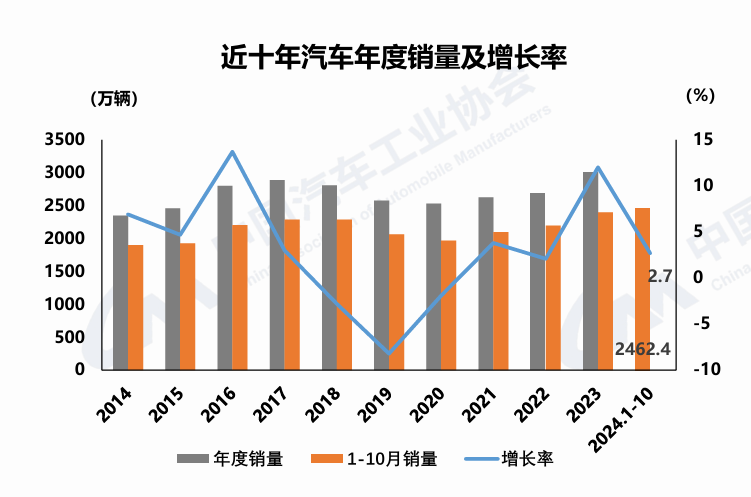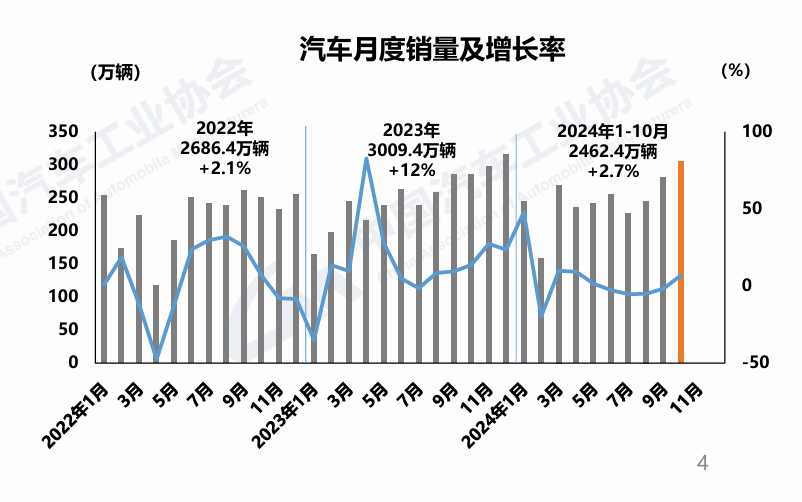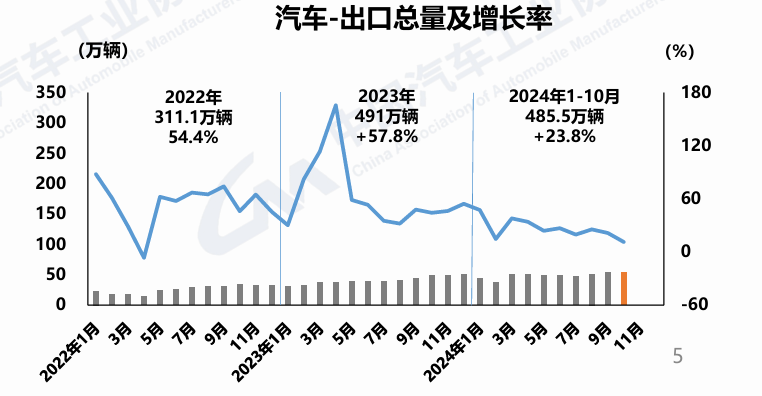With the accumulation of positive factors in economic recovery, China's economic prosperity continues to improve, and business confidence has also increased. In the automotive industry, the trade-in policy launched by the state has had a significant effect on stimulating automobile consumption, and automobile exhibition activities are blooming everywhere, and the market heat is rising. According to the latest data from the China Association of Automobile Manufacturers, auto sales increased in October both month-on-month and year-on-year. The passenger car market continued to maintain good momentum, driven by multiple favorable factors, while the commercial vehicle market performed relatively weakly. The export market for new energy vehicles and automobiles maintained a rapid growth rate. With the continuous release of policy effects, coupled with the active promotional activities of car companies and dealers at the end of the year, it is expected that the auto market will continue to maintain a growth trend in the next two months. The China Association of Automobile Manufacturers predicts that the auto market will maintain an upward trend in the next two months.

Figure: Annual sales and growth rate of automobiles in the past ten years (Source: China Association of Automobile Manufacturers)
According to the information conference of the China Association of Automobile Manufacturers, automobile production and sales increased year-on-year. In October 2024, China's automobile production and sales reached 2.996 million units and 3.053 million units, up 7.2% m/m and 8.7% m/m and 3.6% and 7% y/y, respectively. From January to October, vehicle production and sales totaled 24.466 million units and 24.624 million units, up 1.9% and 2.7% y/y, respectively. In October 2024, passenger vehicle production and sales totaled 2.706 million units and 2.755 million units, up 8.2% m/m and 9.1% m/m and 7.7% and 10.7% y/y, respectively. From January to October, passenger car production and sales totaled 21.349 million units and 21.434 million units, up 3% and 3.7% y/y, respectively. In October 2024, commercial vehicle production and sales reached 290,000 units and 298,000 units, respectively, with production down 1.5% m/m and sales up 5% m/m. The year-on-year decrease was 23.3% and 18.3%, respectively. From January to October, commercial vehicle production and sales totaled 3.117 million units and 3.19 million units, down 5.1% and 3.4% y/y, respectively.

Figure: Monthly sales and growth rate of automobiles (Source: China Association of Automobile Manufacturers)
In addition, domestic sales and exports of automobiles also achieved year-on-year growth. According to the China Association of Automobile Manufacturers, vehicle exports in October 2024 totaled 542,000 units, up 0.5% m/m and 11.1% y/y. From January to October, exports totaled 4.855 million units, reflecting a 23.8% y/y increase. Passenger vehicle exports in October 2024 totaled 465,000 units, up 1.8% m/m and 10.7% y/y. Passenger car exports from January to October totaled 4.1 million units, reflecting a 24% y/y increase.

Figure: Automobile - Total Exports and Growth Rate (Source: China Association of Automobile Manufacturers)
In 2024, China's auto market will show a trend of production and sales growth in general, especially the new energy vehicle market. In 2024, China's new energy vehicle field will also usher in a number of important technological breakthroughs. For example:
Progress in battery technology: Lithium iron phosphate (LFP) power batteries account for nearly 70% of the vehicle, low-end models mainly use LFP batteries, while high-end models mostly use ternary lithium batteries. In addition, the Kunpeng battery solid-state battery developed by Chery Automobile has achieved an energy density of 400 Wh/kg in 2024 and is expected to reach 600 Wh/kg by 2025, marking a major breakthrough in battery technology.
Innovation in charging technology: The 800V high-voltage silicon carbide platform and 5C super fast charging technology equipped with VOYAH have greatly shortened the charging time, and the charging time can meet the commuting needs of 100 kilometers in 3 minutes. The application of this technology has significantly improved the charging efficiency and changed the traditional charging mode.
Improvement of intelligent driving technology: In 2024, the proportion of new energy vehicles with L2 and above autonomous driving will reach 62.5%, an increase of 7.2 percentage points year-on-year, showing that the loading rate of intelligent assisted driving systems is increasing year by year.
Independent breakthroughs in core technologies: Chinese automakers have made significant innovations in a number of new energy vehicle technology fields, and Dongfeng Motor has independently mastered core technologies such as "Longqing" for commercial vehicles and "Mach" for passenger cars, as well as quantum architecture, effectively filling the technological gap.
These technological breakthroughs not only improve the performance and user experience of new energy vehicles, but also lay a solid foundation for the sustainable development of the industry.






